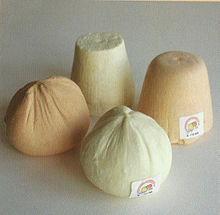Afuega'l pitu
This article needs additional citations for verification. (March 2013) |

Afuega'l pitu is an unpasteurised cow's milk cheese from Asturias, one of four Asturian cheeses (the others being Cabrales, Gamonedo cheese, and Casín cheese) to have been recognized with Protected Designation of Origin (Denominación de Origen, DO) by Spain and the European Union.
The name comes from its tendency to stick to a person's palate ("pitu").[1] It is considered[by whom?] to be one of the oldest Spanish cheeses. Production is centred on the municipalities of Grado, Las Regueras, Morcín, Pravia, Riosa, Salas, and Yernes y Tameza with the municipality of Grado having the largest production and being the headquarters of the council of Denomination of Origin.
The cheese is produced all year long although principally in spring and winter due to the elevated fat content in milk in the spring and winter months.
Process
The cheese is made from cow's milk from cows milked in the afternoon or evening and heated between 25 °C and 30 °C (77-86 °F) with a coagulant added so the milk forms curds. After midday the following day, the curds are cut and deposited in a mold to drain. From the mold it is passed to a sack or bag ("Fardela") for the "Trapu" version or left with the form given by the mold ("Troncado"-Trunk) like a bishop's mitre. Salt is added, as is paprika (pimentón) if desired. After a few days the period of curing starts with aging occurring on wooden planks for a period between a week and several months.
The resulting cheese is normally white (blanco), with a red (rojo) variety is also made where Spanish smoked paprika (pimentón) in its "sweet" and/or "spicy" ("picante") varieties are added to the cheese before moulding to shape using the form ("Troncado"-Trunk) or cloth bag ("Trapo" or "Trapu").
It also comes in soft and semi-hard varieties depending on the duration of curing.
Varieties
There are two main varieties according to the form given to the cheese:
- Troncado/Atroncáu (Trunk): With a form like a bishop's mitre or inverted flowerpot from the mold used to drain the cheese.
- Trapo/Trapu (Rag/Cloth): Rounded like a chestnut with the form given by the cloth bag used to drain the cheese.
and whether or not paprika is added:
- Blanco/Blancu (White): Without paprika.
- Roxu/Rojo (Red): With paprika and/or cayenne.
Depending on the length the cheese has been aged it can be:
- Cured
- Semi-cured
- Soft
References
- ^ InfoAsturias Archived September 27, 2007, at the Wayback Machine
